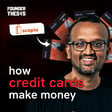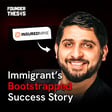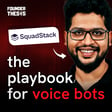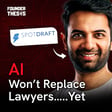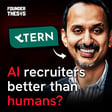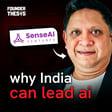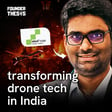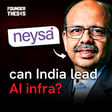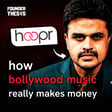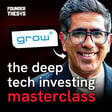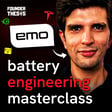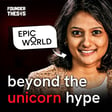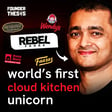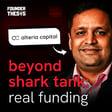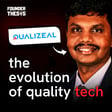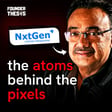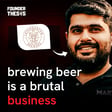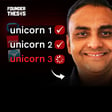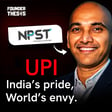Become a Creator today!Start creating today - Share your story with the world!
Start for free
00:00:00
00:00:01

Building the SUV of scooters | Aravind Mani @ River
River is pioneering a scooter for entrepreneurs, giving them utility and lifestyle benefits in a single machine. Aravind shares his approach towards building a startup frugally and decodes their path to becoming a 100-million-dollar business.
For more such interesting founder journeys, subscribe to our newsletter www.founderthesis.com
Read more about River:-
1.River Indie first ride review — A ‘Surprising’ UV of scooters
2.Meet River Indie: The SUV of scooters with a price tag of Rs 1.25 lakh
3.Two-wheeler EV Manufacturer River Bags $15 Mn Funding From Al Futtaim Group, Others
Transcript
Introduction to River and EV Scooter Landscape
00:00:00
Speaker
Hello everyone, I'm Arvind, I'm the co-founder and CEO of River.
00:00:15
Speaker
EV scooter maker Ola Electric has raised more than $1 billion till date. Its close competitor, Ether, has raised more than $300 million till date. Competing against them is a company that has raised just $13 million at the time of the interview.
00:00:31
Speaker
In this episode of the Sounder thesis podcast, your host Akshay Dutt speaks to Aravind Mani, the sounder of River, an EV scooter startup. River is pioneering a scooter for entrepreneurs, giving them both utility and lifestyle benefits in a single machine. In this fascinating conversation, Aravind shares his approach towards building a startup frugally and decodes their path to becoming a $100 million business.
00:00:54
Speaker
Stay tuned if you want to learn about how to build a frugal business. And don't forget to subscribe to the Frundy thesis podcast on any audio streaming app.
Achievements and Strategy with Limited Resources
00:01:13
Speaker
So we are an AV startup based out of Bangalore. So we are only two years old. What we achieved in the past couple of years is phenomenal progress. So we got a product designed, built and ready to manufacture from scratch in just two years, number one.
00:01:29
Speaker
Number two, we've been working as R&D team of close to 300 engineers and designers who are hands-on designing the vehicle, designing the frame, the battery pack, electronics, everything. And number three is we put up a factory for mass production. We got the factory ready and it is ready to mass produce. So all of this was achieved in two years and less than $15 million.
00:01:56
Speaker
And what we've done in the last two years is to set up a good base, which is ready to scale. And we are in the process of taking the product to market in August and then scale to across the country in the next few months to come. I am curious to know how, like, you know, $15 million is fairly small considering what your competitors have raised. I think there's nobody who's raised less than $100 million, right? The people you are competing with.
00:02:25
Speaker
Also, you need to factor in the period of time they have been in existence, right? So, we are only two years and we are 15 grand dollars in those two years. So, one important aspect to this was to get the product to market in the shortest possible time and without compromising on quality or any of the processes. So, being a startup, that's an important aspect to the strength of the company, right? So, one important thing that we kind of
00:02:52
Speaker
focus on is agility. So we're very agile as a company and we had very strong focus on what we were going to build. So we want from day one, we were sure what is the product that we are going to build, what is the specification, what is the market positioning, etc, etc. And we just executed it with great efficiency. So that is important thing.
00:03:14
Speaker
Based on the stage of the company, we have raised adequate capital. That is an important part. And the stage was so initial seed of $2 million was for product development. We kind of put around 15 prototypes on the road within a year. Then we raised $11 million, which is to take the product into mass production, including investments for tools for mass production, the factory, etc., etc.
00:03:39
Speaker
And then the further money that we will be raising will be used for taking the product to market.
Targeting the Utility Lifestyle Niche
00:03:45
Speaker
So one thing you're saying is focus. You did not waste time or money in experiments, which a lot of early players had to waste because there was no ecosystem. Everyone was figuring things out. So you had the benefit of not being the first mover, the late mover advantage that things to some extent were already figured out. So you were very clear and focused on what it is that you want to build.
00:04:10
Speaker
Definitely not denying it. So we do have the benefit of what we call hindsight. So we kind of understand what went wrong in certain experiments in other players, etc. with other players. So that's definitely there. Having said that, it's extremely important to know the process of automotive development.
00:04:30
Speaker
So that really comes from experience. So my co-founder, Wipin, spent close to eight years building vehicles for Honda across Japan, Southeast Asia and India. He has taken around seven products from concept to commercialization during his time at Honda.
00:04:45
Speaker
And in addition to the benefit of hindsight that we have, we also know what exactly it takes. We understand the processes. We understand where we can optimize in the product development, which many startups in the space did not have before us or even the peers to us, because most of them surely do not have the kind of experience that we come with.
00:05:06
Speaker
I think both of you were working at another EV startup. Just tell me that journey of what made you guys connect. Help me understand that journey of ideation to your like raising the first check. Right. This particular EV startup I joined there in 2018 with a mandate to take the product to market. It was spent two years. I was not able to make significant progress there.
00:05:29
Speaker
So, it was one of the multiple reasons the momentum was missing, the product was not in the state to take to market. They should probably hide you a year or two later. Possibly not also. We have kind of proved that with the right steps, we can take a product to market in two years time. So, we strongly believe that every business needs a niche. If you are a young consumer business, there should be a niche in terms of value proposition, in terms of the customer that you talk to that you really have to go after.
00:05:55
Speaker
So for that, the answer to that after a few months of ideation for us was utility lifestyle. So we wanted to create a niche around utility lifestyle in India. So the thesis there was quite simple. More than 50% of India was self-employed.
00:06:11
Speaker
and there are solo entrepreneurs who will be running their own shops. And there is a large part of the day that a two-wheeler is involved in. They carry a lot of things on the vehicle or a two-wheeler for their work. That's also their primary mode of commute. Now, people do that on the existing two-wheelers. However, the form factor was not really suited for them to kind of do that. So people do that in uncomfortable ways, etc.
00:06:36
Speaker
So, we kind of also, that is one trend. The second trend is that the youngster of today, like a 21-year-old who is just out of college, he is a solo entrepreneur, but doesn't mean that even though he does eucalyptus, doesn't mean that there is a lack of style coefficient in his life or personality.
00:06:56
Speaker
And he or she will want to kind of also a vehicle that reflects their personality a lot. So combining these two, we kind of thought that utility lifestyle is a niche that we want to. And the combination of utility and the lifestyle that they stand for is the value prop that we need to bring to market. That is how river was formed. We want to create a parallel of that in the Indian diva space. Okay. Interesting.
00:07:21
Speaker
So this is not something you're doing for gig workers, delivery stuff, logistics. Logistics was not the primary aim here, or was that the problem?
00:07:30
Speaker
I don't think logistics or the gig workers are the primary market because the market is very small. So we are targeting solo entrepreneurs. So it can be a shop owner, it can be a home maker, it can be electrician, it can be a carpenter. See this category of workers or this category of the population is massive and they all earn significantly more wealth than significantly more money than the blue collar workers out there.
00:07:58
Speaker
And they have disposable income, they all stand for a particular style statement. And we want to celebrate their livelihood. We want to celebrate what they stand for. Interesting. So this fundamental thesis, what kind of design decisions did it lead to in terms of how did you translate this idea into an actual design?
00:08:17
Speaker
Absolutely. So now with this utility lifestyle niche in mind, we started back to the drawing board and thought if we were to reimagine a scooter out there, how would that look like? So we started off with a few keywords, like we wanted the product to be very capable.
00:08:34
Speaker
We wanted the product to be versatile because the people who use it for utilitarian tasks also use it in the morning to play cricket and also use it in the evening to take their girlfriend out. So it has to be suited for both work and life and fun.
00:08:50
Speaker
The eventual evaluation of that is what you see in Indy today. So Indy has the largest storage in any scooter out there, not only electric, but any scooter out there. So we have 43 liters of storage under the seat and 12 liters of storage in the front box that puts together 55 liters of lockable storage, which is the top, which is the highest in any scooter out there. We have 14-inch wheels, which is more of a cross between a motorcycle and a scooter, better rideability and maneuverability
00:09:19
Speaker
all road conditions. So we'll also appeal to the rural and semi urban audience. That is also. What is the wheel size of like say an Activa? 10 inches. Okay. So that is second. We created a very large floorboard and you carry a lot of things on the floorboard. So we created front foot pegs, which are seen for the first time in any scooter out there, because once you carry. You don't have to put your feet on the floorboard. You can put your feet on this foot pegs. Is that what?
00:09:48
Speaker
on the front footpegs. So the rear footpegs are very common. You can see that in any scooter. You can also see that in most motorcycles. So we have kind of integrated a footpeg into the front design. And that kind of gives you a very comfortable ride and a safe ride, even when your floorboard is very loaded. So loading a floorboard is not only a utility task. You go buying grocery. You put things on your floorboard. You put a laptop bag on your floorboard. And that's something that everyone uses.
00:10:15
Speaker
and the front foot peg is the first time in our vehicle. Then the next is a customizable platform where there are a few elements starting with the lock and load pannier stay which is featured in the first time in any scooter in the world in indy where
00:10:35
Speaker
You can easily mount several accessories on the pioneer state. We are also designing those accessories. So it is kind of creating a safer, much better way of carrying load. Give me examples of some of these accessories.
00:10:51
Speaker
So there are side penny boxes, there is a back box that can be mounted in less than 30 seconds. So in case you want to carry, see you are a home maker, you want to deliver a cake. Yeah. So it can be done by using a back box without the cake getting spoiled. And you can load up the back box in like 30 seconds, deliver the cake and remove the back box once you're back and your brilliant seat is free.
00:11:14
Speaker
Interesting. So typically, like most people go to a mechanic or a two-wheeler accessory shop for these add-ons and customizations, you have created a modular approach where they can just buy these add-ons. Absolutely. And it's not a permanent fixture.
00:11:32
Speaker
That's more important. It's not a permanent fixture, and that doesn't actually restrict your two-wheeler to be only used for one particular use case. So it is a customizable platform where you can put on these accessories, remove these accessories, and get on with your work and life at the same time. So you buy one product, which is what most people, most consumers do in the market, and you can do a variety of tasks.
00:11:55
Speaker
Your co-founder is obviously from the automotive background and he would probably be doing the design work. What was your contribution in this?
Capital Efficiency in Hardware Business
00:12:03
Speaker
So, I am the business guy, I am the commercial guy. So, unlike public perception, EV startup also needs to make money. I think there are two primary contributions. One is that there is a large public perception or even perception among investors that a hardware business is capital intensive.
00:12:23
Speaker
So we were kind of so far has been a constant proof that harder investments need not be capital intensive. So what we've achieved in the last couple of years and $15 million is a right base on which we can build a billion dollar business.
00:12:39
Speaker
how you achieved this. So the capex for any particular part, for example, the plastic part, so the headlights, etc. These are headlights that will only be there on Hindi. And we will have to do the capex for it. However, understanding how to do it, understanding what is the process, the terrible supply chain industry uses is very important. So we have a very simple product development process, which is a five step process. At the end of each step, we had a significant milestone.
00:13:08
Speaker
and also significant risk is addressed like for example the first stage is what we call the design and ideation stage so we did a clay model of the product which is a one-to-one clay model which is not a skill set that most startups out there have so
00:13:23
Speaker
You don't actually do kit prototypes before the clay model. So in the clay model itself, you can test a lot of things, including the overall dimension of the product, the writing dimension, how does it suit for a five foot two inch person versus a six foot two inch person. So a lot of these writing dynamics, et cetera, can be already fixed on a clay model, which is clay. We are not spending money on prototyping.
00:13:48
Speaker
Once that is done, you scan the clay model and create a 3D. This is very old automotive design process. You can see that the large automotive OEMs will be doing it.
00:14:02
Speaker
Then you move into digital space with this clay and you kind of do very fast iterations. So, for example, we would have done at least four or five iterations on the frame. So, we do an iteration, we do quick prototyping, we put it on the road, we test it, we break it, then we go back to the drawing board and then we do this fast iterations.
00:14:20
Speaker
These iterations are done on the clay model or like you use 3D printing. Once the clay is done, 3D printing is one of the methods. But for example, the first frame was completely hand welded here. So the second phase was what we call the basic engineering phase, where we did a lot of
00:14:38
Speaker
fast iterations of the product, which is software kind of iterations on hardware, which is possibly the first time in the industry. So you build a frame, you put out a vehicle, you build a drive frame, you put on a vehicle, you test it, then you go back. Then along with this, we also did a lot of benchmarking in terms of what is there in the vehicles out there, in terms of method of manufacturing,
00:15:06
Speaker
So, we had a view and site on the cost and how a process is, how a particular part is manufactured from day one. So, that is second phase. At the end of basic engineering, we had a running prototype which is in the final shape and form. Your co-founder would have seen these best practices at Honda and would have been able to bring them over here.
00:15:29
Speaker
I think there are best practices that they followed in a larger company like Honda. And how do you optimize it to your innovation that has happened with young engineers, right? Then you enter a phase called detail engineering, which is a third phase, where you do two things. One is design for manufacturing, and the second is design for assembly. This is where we took help from a lot of Taiwan partners. And like, for example, there is a Taiwan supplier who makes
00:15:56
Speaker
headlights or bajaj two wheelers. There is a tire on supplier who makes frames for Honda scooters. So we work with these guys very efficiently kind of see this is the design they have made. Can you look at this design and say where we can optimize it from a manufacturing perspective. So we did that six months into the inception of the company. It's extremely efficient process. We got the feedback. That is what we call design for assembly and design for manufacturing.
00:16:20
Speaker
So, can this be manufactured at mass scale is a question that we asked that iron suppliers at that time, we got the feedback we optimized it for manufacturer ability and how do we assemble all these together from a simple assembly perspective.
00:16:35
Speaker
That is the third thing. So at the end of along with this, there are multiple other things that happen in terms of the electronics that they're building. How do we make the vehicle architecture? Very simple. So I think something under ideation and subtraction is something that we do really well as a company because it's easy to make things complex. It's very difficult to make things simple. So how do you subtract, subtract various things that you want to do?
00:17:02
Speaker
How do you keep it to the bare minimum? How do you focus on what is the most essential part is something that we've done really, really well as a company. So at the end of the detailed engineering process, we had 15 prototypes with parts from supplier lines, with parts with feedback from Taiwan suppliers. We've onboarded all the major Taiwan suppliers that we wanted. And these three phases we ran in 11 months.
00:17:32
Speaker
and spending $2 million. Amazing. How did you raise that $2 million? $2 million was raised on sitting in our drawing rooms, drawing code times, pitching to investors all over. Even in fact, the first check that we got, the investor did not even see us.
00:17:48
Speaker
Okay, there's like a friends and family or? No, so the first checks. Seed funds and Angel funds. It came from Israel-based menu mobility, which is a mobility-focused venture capital fund backed by Sundai, Mercedes, so Renault, Nissan, etc. And another VC called Trucks VC, that is San Francisco-based VC. So these two funds, they wrote us the first $2 million check and that is how we started.
00:18:18
Speaker
Amazing, okay. How do you convince a supplier to take you seriously? You know, as a young startup with no track record behind you, how do you get a tier one supplier to work with you? So it was possibly more difficult than convincing an investor to give us money. Yeah, I would have thought as much. Because most of these tier one suppliers understand the process really well, right? Because we told them, see this is what we're building, this is the niche that we're going, we are not a me too product.
00:18:48
Speaker
We are really going after a different niche. We are a clearly differentiated product. So that is one important thing, product pitch. Number two is to understand how the process works within their ecosystem and work towards that. For example, us taking a frame to them and telling them, see, can you tell us how to improve this? This is something that people welcomed.
00:19:09
Speaker
People are like, okay, you guys are doing something really different and we love to be a part of this journey. That is an important part that happened. And at that point of time, when we had the focus on the product, on the process, that kind of helped sell the story also. The skill set of working with vendors is highly underrated. Absolutely.
00:19:30
Speaker
And third point is also to hire the right people. So we were able to get the right kind of engineers and supply chain people from the industry who have worked with multiple OEMs, taken multiple products to market. So it's always a team work.
00:19:45
Speaker
Okay. And these would have been like people from large ICE manufacturing companies who have already worked in the ecosystem, have the relationships. They immediately bring credibility to the team. They understand how to convey information. I'm sure like, you know, if you're getting an app build, then you have to give a business requirements document and you have to give a wireframe, et cetera. So something similar would be the case here also, like
00:20:07
Speaker
Absolutely. So as a young startup, when we got the seed funding in March 2018, it was just two of us. So from that, by the time we were in March 2022, we had a team of 80 people, which was primarily split. We were very sure of the skill set that we wanted to go.
00:20:25
Speaker
So our R&D today has got five verticals which is mechanical, electrical, drivetrain, connectivity and design. And there are several horizontaries which are like the supply chain, manufacturing, program management, development engineering. So whatever the design
00:20:42
Speaker
A vertical dust has to be signed off by supply chain for cost, development engineering for manufacturability, manufacturing for how can you assemble it, program for time. So this is the fast iteration that I was talking to you about. So it's a team that, R&D team of 220 people flat, and that's a peak strength. And we took a product from sketch to mass production in flat two years.
00:21:06
Speaker
Amazing. You said you had 15 prototypes ready after that process, the design engineering process. So what happened next?
00:21:14
Speaker
After the third step, which was called a detail engineering. So it was first is ideation. Second is basic engineering. Third is detail engineering. At the end of detail engineering, we had all the tier 1 suppliers onboarded and we had 15 prototypes. Then we started testing these 15 prototypes and those are still running on the roads. After that, we had to go into mass production. So then it is about developing mass production tools for these products.
00:21:40
Speaker
But you wanted to do all 15 or was it a process of elimination? No, we had to build the 15 because see all these 15 were also used for different kinds of testing. So say around eight of them are going for on-row testing, two went for destructive testing, two went for shock absorber testing. Yeah. Oh, so you're saying that they're not 15 different designs, but one design 15 variants, like 15 copies of it. Okay. Got it. One design 15 copies of it. Yeah.
00:22:09
Speaker
And then we went into pre-production batch where we have 50 vehicles. So the first step was to build one prototype, then 15 vehicles, then 50. So today we have 50 vehicles which are from the pre-production batch, which is with all the parts from the supplier ends. And we have been testing them on the road for the last several months. We have already cumulatively covered 100,000 kilometers on these vehicles.
Testing and Gradual Scaling Plans
00:22:33
Speaker
We have done durability testing to the equivalent dunes of 150,000 kilometers, etc. In parallel, we went ahead and blocked the factory land. We ordered the line. We designed how the vehicle will be assembled.
00:22:49
Speaker
In parallel, the R&D setup also grew from a 6,000 square feet space. We grew to a 70,000 square feet space with a fully-fledged design studio, mechanical workshops, mechanical labs, electrical labs, electrical workshop, battery lab. So today, the R&D facility that we have in Whitefield, Bangalore is a self-contained unit where we can design a product, build up to 50 prototypes, test them extensively, and transfer it to the manufacturing facility.
00:23:19
Speaker
Amazing. Is there an agency to whom you can outsource the testing? Like 150,000 kilometers if you have to run? Is it like your employees who are actually doing so much, like going out and ride? OK.
00:23:33
Speaker
Yeah, we have contract riders who kind of, their job is to only ride the vehicles. So, it is a 24-hour operation and they take the product out, they ride it. In fact, we do this in multiple cities for different temperature conditions, temperature, humidity conditions, etc.
00:23:50
Speaker
So road conditions and all. Absolutely. So once they come to below 10%, they bring it back to the facility, charge it, and then again go back. So there are also testing agencies that we work with for durability testing, destructive testing, etc., because we haven't done all this capex investment for these testing facilities in-house.
00:24:10
Speaker
So it's always a balance that we strike as to what is the most essential that needs to be done in-house. The rest we have partners with whom we kind of see there are multiple testing agencies like air, ICAT, et cetera, who we work for, say multiple other tests like two-post, torture track, et cetera. These are things that you don't really have to invest in-house. Got it. Okay. Your team of 80 people you built in a year with just that $2 million, was that enough?
00:24:41
Speaker
That was enough. See, 2 million was there in the bank and we never compromised on speed. So, we knew that the 2 million will get us 15 vehicles and we never stopped fundraising. How much runway did you have left when you raised the next round of 11 million? Always the runway was close to a year. Always it's less than a year. So, you were really frugal in your hiring. Absolutely.
00:25:07
Speaker
We only hire what is essential, who is essential. So if you were growing in three organizations, one is the R&D organization. The peak strength of it is almost 200 to 220. So that is the organization that will conceive products, build the next generation technology, and test the products out for perfection, take it to mass production. Second is the manufacturing organization, which is the factory, which will mass produce these vehicles. And third is a commercial organization, which will start selling and servicing these vehicles.
00:25:37
Speaker
So today RMD organization is 100%. Manufacturing organization is close to 30%. The commercial organization is again another 30%. And we will be scaling on these two as being more. So the whole... As your go-to-bucket progresses.
00:25:53
Speaker
Yeah, we have already hired manpower to start selling in one city in the month of August. And once you prove our distribution model in one city, then it's a copy-paste mechanism that will happen. What's your median salary in the R&D function? Median salary. See, we don't pay lower than market. Every employee also gets CSOP.
00:26:10
Speaker
Okay. So like a lot of startups, when they get funding, they go all out in terms of hiring the best talent, even if you have to pay 20 lakhs, 30 lakhs, 50 lakhs, one CR. I mean, these are not like in software roles, especially these are like fairly par for the course. Did you want to say, let me not chase that talent which everyone else is also chasing? Because EV talent, I'm sure would be like,
00:26:33
Speaker
you know, a lot of takers for EV talent and driving up salaries. How did you avoid that game of competing on salaries? So one thing as a company, as a brand, we do not believe in hype. Whether it is on the market, whether it is in price or whether it is in salary, we do not believe in hype.
00:26:51
Speaker
We are building a company and we know that to build a brand in the two wheeler space, it is going to take a long time and we are in it for the long term game. We don't attract people who will want to join for a 100 or 200% hike. So we believe our hiring philosophy was always very micro entrepreneurial. So for example, we knew that, okay, we want a design head.
00:27:14
Speaker
who will need so much of skill set and we took a design head and we gave that particular person a freedom to build an entire design team. We similarly took a mechanical head and we gave that person the entire freedom to build a mechanical team. So that is, and each one of them are micro entrepreneurs within river and that is a culture that we want to kind of
00:27:38
Speaker
And that has given us a lot of success in the past and specialize on building. We spend time on building that. Everyone feels a sense of belonging. Everyone feels that this is a particular department that I need to run. And this is the amount of resources I need to run this. And we let them run it on a free scale.
00:27:57
Speaker
You would have probably also taken some calls that, for example, I don't want to hire people from an existing EV company because they will be costly. Let me instead go to ICE companies because I will get talent which can learn EVs, learn on the job, and maybe they don't hit the ground running, but in a month or two, they will be there. Maybe you would have taken that kind of a call.
00:28:19
Speaker
True, two important philosophies there. One philosophy is that we will not hire from, we do not also go out and hire from companies because thought process and DNA matters. So if a thought process and DNA does not match with the quality constraints, the agility that we stand for, then we do not want that resource. So more than the technical skill set, what really also matters is the SCA. So that's number one.
00:28:43
Speaker
Number 2 is to have the right balance between experience and fresh thought process. Because someone who is a 3 year old engineer will bring a completely different perspective to this. As long as that person is given the right hand holding and exposure to how existing industry works. You can't change the way tier 1 OEM works. Tier 1 company, the way a frame building works cannot be changed. However, this person can build a new frame.
00:29:14
Speaker
But how do you take it to mass production is how a tire one works. You really can't change it there. So it's a right mix between the fresh thought process and the knowledge of how the industry works. Interesting. And what are the kinds of companies where you think the value systems match? For example, maybe you don't want to hire from existing EV companies, but there would be some companies where you would say, okay, people from this kind of a company have a good fitment with us.
00:29:41
Speaker
For the last two years, as far as R&D is concerned, our focus was to build a good product. So the entire focus was on the product. So any company where the value systems match where, see all the traditional OEMs for that matter.
00:29:56
Speaker
Their focus on quality is quite high because they have been around for decades. Customers have, we are happy with that value system. However, the process followed there may be redundant today to a large extent or may not be suiting the concept of agility that we have. So, we need their understanding of the industry process. We need their focus on quality. We need their value system from a traditional OEM.
00:30:22
Speaker
We need the young manpower who can be a fresh engineer out of college or someone who has worked in another startup where agility is available, where a fresh thought process is available. Now, how do you marry the fresh thought process into the existing process available in the industry is where the trick is. That is what... Yes.
00:30:43
Speaker
Okay, interesting. Like you would have wanted to take up like someone from a Maruti or a Bajaj who is young in the system, not yet set in the ways, willing to unlearn some of the things, but at the same time brings with him industry knowledge, focus on quality, attention to detail, all of those things, because you learn those things
00:31:02
Speaker
Someone who actually thought that I could have done this, but a large OEM will not give him or her the space to try that out. We give them the space to try that out. Interesting. Our second level of management, our leadership, the sweet spot is between 10 to 15 years of experience. Beyond that, what we call is you get institutionalized. Yeah. Okay. Interesting. Interesting. How did you raise that next round of 11 million?
00:31:29
Speaker
So, we have made significant progress by the time we had those 15 vehicles running on the road and there was a large team. See, when we raised the two minutes, it was just a presentation and two of our resumes. Yeah, that happened, which basically. Yeah, absolutely. So, the second time we had significant progress, right? We had a clear product.
00:31:49
Speaker
There were 15 vehicles running on the road. All the tailwind supplies were onboarded. We had basically addressed a lot of risk, including technology risk. We had made our own battery pack, the product risk to a large extent, supply chain risk to a large extent, and then it was slightly easier. What are these risks which an investor has in mind? So technology risk means risk that the technology you want to use is not mature or cannot deliver. Just help me understand this.
00:32:18
Speaker
You can say that my battery pack, there is a pitch that we have a battery pack that works. Now, in the first round, it was like, we will make a battery pack that works. And in the second round, it is like, see, there is a battery pack that works. Okay.
00:32:38
Speaker
yeah okay okay okay and product risk is what like like whether there is a demand for the product will people want to buy that is an important thing which is getting addressed right now a product risk is kind of product function in itself so what do you say is a product market fit with the
00:32:54
Speaker
With the launch event, we have a bunch of pre-orders that we want to kind of start servicing now. So now, the next important thing is that we need to start manufacturing, we need to improve our distribution model and we need to start selling to our customers. Okay. I believe you used the investment banker for this round of 11 million and I wanted to ask you... No.
00:33:15
Speaker
No, no investment banker is used. All the fundraise was done completely in house. So it was a story that we told about the product that we wanted to build and a constant thesis that a hardware startup is not capital intensive. Like people are comfortable giving $15 million to a software company and another $15 million to scale that business. So what we are telling is with this $15 million,
00:33:41
Speaker
We have invested on a factory and a product. And if you send 5,000 units of this product, you have built yourself a hundred million dollar business. So to build a hundred million dollar business, you only have to send 5,000 units. And all the investments to build to sell that 5,000 is done.
00:34:04
Speaker
It's a very strong pitch. Yeah, it is. It is. Absolutely. Planned production capacity. The installed capacity of the factory in three shifts is 100,000 units a year. That roughly translates to around 9,000 units a month. We are starting off with a single shift operation because we are only going, we are also, we also have a city-wide scale-up plan. So we are going to be in one city in August, a few cities down the line. By January, 2024, we will, we target to complete. Okay.
00:34:34
Speaker
Got it. What would happen if once you started selling the vehicles, you discovered a flaw, either in the design or in the battery pack or whatever. There could be so many things which can get discovered later. There is this thing going around in social media about Ola's fork. I believe there is some problem there and the fork breaks. It's not designed for Indian conditions. Even with the best of intentions, you might discover a flaw later on. What happens in that case?
00:35:04
Speaker
So I think it is extremely important to be honest with the consumers because they are the first people who really backed us. So we have been telling a story to everyone right, whether it is an investor or a supply chain partner or a potential employee or an employee or even a consumer, we are telling a story of what we want to do as a company.
00:35:24
Speaker
So, I think we will be honest with the consumers. First of all, we are very confident that fundamental flaws will not happen in basic functionality. If a partner is supposed to do a function, it is as a responsible OEM, it is our job to make sure that
00:35:41
Speaker
that part is tested to do that particular function. And we have done that. So we do not believe that fundamental flaws are going to happen for the consumer. And we will take care of the product. We will replace whatever parts are there and make sure the customer does not have to pay for it. And you have enough capital cushion to handle such a situation because you may need to shut down production. Like maybe your revenue takes a hit for a few months or stuff like that.
00:36:08
Speaker
Absolutely. See, the thing is also such a drastic thing. See, for example, if it's a drastic problem, then we will do the right thing by the customer. At the end of the day, values that we stand for is more important than short-term profit. So we are not another mill operator who wants to sell a few vehicles, make a few bucks and run. We are an OEM that is creating a product that our customers' average usage will be at least five years.
00:36:36
Speaker
So we'll do the right thing by the customer. Yeah. Right. Help me understand your distribution strategy, because you're not just distributing a vehicle, but also the components, the modular components, like the box to, like you gave an example of someone delivering a cake can just attach a box. What's the way in which you will do this? Is it more online or is it like traditional form of dealers? So we, no, we will work.
00:37:06
Speaker
Traditional form of dealers is a beautiful model that works in the industry, has worked in the industry for multiple reasons. Top reason, they fund the working capital.
00:37:16
Speaker
because the dealers buy from you in advance and you pay your suppliers later. So the working capital which is required to scale, if you are funding it 100%, you're talking about a large capital reserve that you need, which is not the most efficient use of capital. And if you're scaling through 100 dealers, you are primarily distributing that working capital requirement to 100 dealers. So it is a beautiful, the model that works beautifully in the market today. We do not want to reinvent the wheel there. That is number one.
00:37:44
Speaker
Number two, selling and servicing a two-wheeler is a very localized experience. So the consumer will want to really go talk to someone, at least today, they want to see, have the comfort that, okay, there is a store here, I can take my product too, in case there is something wrong. There is a person there. So it's still a very localized experience. Having said that, we do not believe that a city will need 50 dealers.
00:38:11
Speaker
A city will possibly need five dealers, but not to the extent. So we believe that there is going to be a hybrid method of selling where there will be a bunch of customers who will come and place their orders online, but we'll still want to take a product to a dealer for service.
00:38:26
Speaker
It is going to be a hybrid model which is a combination of online and offline. We are creating a system that can work seamlessly for the consumer. So, even if a consumer places an order online, we will transfer it to the nearest zero and the nearest zero will be a fulfillment partner who will service the vehicle. That is also how we believe the dealership model will evolve in the years to come.
00:38:50
Speaker
We are we are building a hybrid setup where the entire data will be controlled company and dealer will be more of a fulfillment partner. So, an eventual commercial implication to this will be that the revenue that a dealer gets from service for a EV will be far lower than what he is getting today for a IC engine business. So, the upfront margins will be higher and that is possibly how the dealership model will evolve.
00:39:14
Speaker
Plus the sale of accessories could add on to his margin. Those would be higher margin products, I'm assuming. Absolutely, yeah. Okay, interesting. The founding team, the two of you were able to pull off in terms of building manufacturing the product because of your past experience.
00:39:34
Speaker
What are you doing on the side of distribution? That is something which you may not have already got with you. The founding team would have probably not got that with you. So what are you doing there too? Because you need to onboard maybe 500 dealers across the country or something like that. So how would you or how are you? Onboard smarter people who have already done it.
00:39:55
Speaker
So we already have a head of marketing, we are onboarding head of dealerships, we are onboarding head of sales. So this skill set is already available in the industry. See, all sudden, because you're following the legacy dealer format, so anyone from a legacy company who has already done this would be able to deliver it to you.
00:40:14
Speaker
I wouldn't say we are following the legacy dealership format primarily because the legacy dealership format has certain restrictions in terms of how the dealer makes money. There is a large chunk of money depending on servers. So we are more looking at dealers as fulfillment partners.
00:40:33
Speaker
and customer experience. We learn to want to work with them in a much more deeper way in terms of how do you sell the product, how the customer experience is going to be, etc. So we hand pick our dealers, we spend time training their staff. So it's not like a missionary that at least for the next year or two years, because the first two years is where we also define our dealership, our customer experience, etc. So we want to have a slow and steady path to get there. See, for example, the target is to open around
00:41:02
Speaker
50 dealerships by 2024. You want to go Pan-India? It will be Pan-India, but with a slightly more focus on tier 2, tier 3 cities. Okay. There is a potential too. Not really. Two-wheelers market, primarily lack of public transportation, makes tier 2, tier 3 cities larger two-wheeler markets, number one. Number two, self-employed people are more and our thesis is always going after the solo entrepreneur. What are you doing in terms of brand building and marketing activities?
00:41:32
Speaker
to attract this solo premiers. So we are also, we haven't spent much money on marketing so far. So we really do not believe in celebrity marketing or any of that. So we believe really in community building.
00:41:44
Speaker
What kind of community activities? Give me some examples. Vocational training for that matter is being planned. How can, or helping them reach the right audience, getting loans for them to buy a product and maybe augment their business in whatever way we can. So because of the higher exposure and the kind of relationships, we will be able to get these kinds, open up these doors for a bunch of these solo entrepreneurs.
00:42:10
Speaker
You would definitely need to offer financing because I believe that's what will make an EV competitive because your cost of running is lower, upfront cost is higher, so most people will need financing for it to make sense for them. And a solopreneur may or may not have a good credit history, credit score, they may be new to credit. How will you solve that problem of helping them to finance the vehicle?
00:42:34
Speaker
See, it's again not reinventing the wheel. It is about working with the existing banks and NBFCs who have only a credit score system. So all entrepreneurs, unlike public perception, are not people without money. Right. But they may not have the kind of documentation which a traditional bank wants before giving a loan, right? Like a bank will
00:42:55
Speaker
There are many NBFCs who are willing to work with these people. There are many NBFCs. For example, we have tied up with two NBFCs and a bank who have already signed up as partners to offer financing for us.
00:43:09
Speaker
Interesting. What is the software play? One of the big advantages of an EV is integration with software and there's a lot of interesting stuff that you can do through software integration, IoT. Tell me about some of the things that you have done, what's on the roadmap there.
00:43:28
Speaker
So we already have developed them in the vehicle is connected, the battery pack is connected and the customer can access all the information about the ride, et cetera, from an app. So these are all things that is already built out. But we are also thinking about building business models around connectivity. For example, leasing of the vehicle, leasing of the battery pack, you buy the vehicle and you lease the battery pack, et cetera, are business models that can be enabled because of software and connectivity on the vehicle. In addition, we're being novelty features.
00:43:58
Speaker
Let's say the whole vehicle costs, what is the target price of it like when you launch? See, for example, the vehicle is being sold for 1,25,000 rupees extra room. If we are leasing a battery pack, we can even sell the vehicle for 80,000 rupees and do 1,500 rupees subscription per month for battery pack.
00:44:17
Speaker
before the battery pack and it also gives consumer a lot of advantages in terms of not being dependent on the battery pack. If something goes wrong with the pack, we'll replace the pack, etc. And what happens to my pack after five years?
00:44:30
Speaker
So yeah, but it's also a customer education problem where you really have to educate the consumer about a lease product. So the point being the software play and the IoT devices or the connectivity modules are designed in such a way that these business models can be enabled at the right time. Like in such a scenario, you would work with a NBFC partner when you're leasing the battery or this will become like a subscription revenue for you. Absolutely.
00:45:01
Speaker
See the thing is, we all always believe in distributed growth. We are not fully vertically integrated that way. For example, the way we want to work with the distributors. You invest in a showroom, we will make sure that you make so much return and you become our partners in growth. Same story with respect to financing also. We are not a financing company. We are OEF. As long as we make our cutout of selling the product and cut out the subscription revenue, we are not in the business of lending money.
00:45:28
Speaker
Interesting. Okay. You know, what do you think will be your, let's say at maturity stage, let's maybe in two or three years, what will be the revenue breakup in terms of how much would you be earning from just selling the bike, how much from accessories and from subscription revenue cut and others kind of whatever? I think subscription. Yeah. Subscription is not something that we want to talk about. See, let me tell you an example of around 5,000 vehicles a month. So by the time we reach a scale of 5,000 vehicles a month,
00:45:55
Speaker
which will be in couple of years from now. The revenue from sale of vehicle will be around 100 million dollars. We think there can be an additional 15 to 20% from sale of accessories and merchandise and an additional 10% from service revenue.
00:46:12
Speaker
And subscription is not something that we'll possibly do in the next couple of years. Okay. Why not like, wouldn't that increase affordability, make it more accessible? I agree with you, but educating a consumer is going to take a lot more time than that. So today, education of the consumer has already happened. As I told you, we believe in agility and we believe in efficiency. So when the time is right, we can do the subscription business.
00:46:39
Speaker
Okay, interesting. And what do you think will be your sales breakup between let's say direct to consumer through dealership versus let's say corporate deals and stuff like that? Do you see corporate deals as a significant part?
00:46:53
Speaker
I don't believe that there is any corporate deal transaction that is going to happen in the country today. Primarily because see who can buy vehicles in bulk like none of the organized delivery fleets as we call it like food delivery or econ delivery or couriers. None of them buy their own vehicles. None of them have vehicles on their books, right? So we do not see too much value coming in from corporate sales. However, we see the order book getting more small, medium businesses.
00:47:21
Speaker
buying vehicles, going forward. Interesting. What is the benchmark number there? If you achieve this much by this date, then you know that you have got product market fit. So, I think that answer is there in the Indian two-wheeler market. See, for example, the spread in the Indian two-wheeler market is so vast.
00:47:39
Speaker
Right at the top we have guys like Honda and Hero who sell 5 million units a year and their businesses are north of 4 billion dollars. They have 5000 dealers around the country. Now all the way down we have brands like Vespa and KTM that sell 5000 units a month.
00:47:59
Speaker
and they are having $150 million business and they have a niche carved out for themselves. So this is the number that I have been telling you for some time since we started this conversation.
00:48:10
Speaker
5000 a month. 5000 a month is 100 million dollars is that number where you can say that, okay, I have created a market or carved out a market for myself. That is the base on which we will build for the business. And how much time will you need to hit 5000? What's your like? A year, a year and a half is what we're looking at. Okay. Okay. Okay. Would you need more fundraise to hit this 5000? Of course.
00:48:36
Speaker
For what? For marketing spend, customer acquisition. For marketing spend, customer acquisition. Typically entrepreneurs are like irrationally optimistic, but just to kind of look at what could go wrong, if let's say you don't hit 5,000,
00:48:56
Speaker
units of sale even after two years, what would have gone wrong for that to not happen? Would it be factors under your control? Would it be some external factors? What are the things which could have gone wrong in case you did not hit the target? Very hypothetical question, but just to understand the risk factors.
00:49:16
Speaker
There are multiple things, right? For example, we are not scaling to the extent that we want. For example, it's also a factor of how many cities are we in. So, if you are not able to reach those cities, then that is one factor that could possibly delay us reaching 5000. See, it's not about reaching 5000. It's about reaching 5000 in a year.
00:49:37
Speaker
or two years or three years. So it's about the pace at which we can scale is one factor. The pace at which market accepts the product is the second, which is very unlikely during given the traction that we already see in the market. We are confident that there is market demand.
00:49:52
Speaker
and supply chain issues, are we able to manufacture fast enough etc. So, this is a business with multiple facets and we are aware of it, we are not ignoring that. So, supply chain and we are actually thinking through each of this on a daily basis. For example, we have all major Taiwan suppliers onboarded. So, this was a pain that we took in the last year so that when we are ready to scale, they do not have capacity constraints.
00:50:18
Speaker
I think supply chain is unlikely unless there's like some battery shortage or something, right? Second thing is manufacturing. We had a choice to put up a factory with a capacity of 15,000 vehicles or 100,000 vehicles. We took the pain and put up a factory with 100,000 vehicles per annum capacity so that when we are able to scale, once we crack it, we can actually replicate it. Same thing. So, we have thought through this in the right way, but we have to also execute it right.
00:50:46
Speaker
Right. You said you're very confident that there is demand in the market for the product and there are signs of traction. What are those signs of traction?
00:50:54
Speaker
the customer service lines, people calling asking for test rights, because we have not spent any money on marketing. The only thing that we spent was the launch event, even opened up test rights for in consumers. We do multiple community activities where we bring in people into the R&D center, talk to them, etc. Everyone loves the product. So these are like automotive influencers, like someone who's got a YouTube channel or something like that, like people.
00:51:20
Speaker
Not even, we kind of, whoever has come to our website and posted their numbers or email ID, we reach out to them and ask them to come to the site. It's not influencers. It's the end consumer who will potentially buy our product.
00:51:39
Speaker
It was in February where we invited the major auto media, business media and influence the crowd and did a launch event where we had a 20 minute video which was curated and we showed it. It was live streamed also and that was only public. It was presenting the brand and the product and the company for the first time to the outer world.
00:52:01
Speaker
So, and from that is the, that is the only, only marketing spend that we have done so far and anything that, any traction or, and our, we have been getting continuous emails, we have been getting continuous calls, etcetera, after that. How did starting river
00:52:19
Speaker
make you evolve as a person, as a founder, as a leader. What were some of those things which some skill sets you had to learn or you know, how did this help you evolve this whole two-year experience? So it's a very humbling experience to start with because see when we started off, right?
00:52:35
Speaker
for someone to actually write a $2 million check without having seen us write, it's extremely important. So we started believing in the power of chance, in the power of taking that one chance. Like for example, all the major investor contacts or the major investments that we have raised has been through cold emails. We have sent cold emails to these people and we got responses, we got conversations. Amazing.
00:52:58
Speaker
That is an important thing. And of all investors who are invested in Ruvar, Ruvar is the first investment of all these companies in India. Wow. Okay. That's amazing.
00:53:09
Speaker
So, we were able to convince a VC sitting in Israel, in San Francisco, a climate fund sitting in San Francisco, the corporate venture arm of largest automotive company in the world. Which one is that? To Putin. Okay. Toyota. Toyota Ventures is invested in the world. Amazing. So, and we are the first investment for all these companies in India, right? That is a very, very humbling experience in itself. We told the story of River
00:53:34
Speaker
to people, to our employees when we did not even have a website and they joined. And they worked tirelessly to build river from a story that they said. We told the story of river to tyrant suppliers with a promise that we want to build this, can you please help us? And they worked with us. So it's an extremely humbling experience, which kind of taught us that it is about the people that you work with.
00:54:01
Speaker
That is most important and you really have to create that environment and find the resources for them to execute and build what you envisioned. It's quite fascinating that you went after not the traditional VCs like Sequoia and all of these. Why did you take this call to send cold emails to VCs outside India?
00:54:25
Speaker
It's not that we didn't go to all of them, but most of them said that hardware investment is not going to happen. We do not want to invest in hardware. I think it is fast aging and we possibly want to be the first example of a company that can prove that a hardware investment is not capital intensive because we are a very mature software app aggregator investor. I mean, a company is that raise money ecosystem.
00:54:50
Speaker
We are a very nascent hardware investment ecosystem and all the predecessors that we have are not capital-efficient to that matter. We want to make that strong statement that we are going to be capital-efficient and hardware investments are not going to be as capital-intensive as you think. And third, India is as great a manufacturing economy as any other country out there.
00:55:13
Speaker
Amazing. What is the eventual exit? Do you see like, let's say maybe a Toyota coming, taking over or something like an acquisition or do you see like public listing or, you know, like very long, long horizon 10 years down the line. What do you see?
00:55:28
Speaker
And yes, around the line, we could be possibly the first hardware company out of India to go and list in an Aztec or we could be acquired. We're not thinking about acquisition at this point. At this point, we are very focused on building river as an individual brand and see how we can build a large consumer-focused business with very strong focus on design. Amazing.
00:55:52
Speaker
You're operating in a space which has a lot of funded startups that you are competing against. What makes you different? What gives you the right to succeed? Every company has a particular philosophy and DNA that they stand for.
00:56:06
Speaker
At River, we are a design centric technology company. So design is extremely important primarily because we are a consumer focused brand. We work, we see around the market, we see what the consumers want and we are creating solutions to better their lives.
00:56:25
Speaker
And design as a skill set is extremely important to that. And we have proved that from the product that we have created in the which is unlike anything out there in the market. So that design philosophy and DNA is what is going to set us apart in the market in the years to come.
00:56:45
Speaker
that is important. So as part of the design, we are also very people centric, people focused company where technology is one, but how do you kind of make the technology useful for the consumer and how can you use technology and design to make their day-to-day lives better is the entire focus.
00:57:08
Speaker
And that brings us to the end of this conversation. I want to ask you for a favor now. Did you like listening to the show? I'd love to hear your feedback about it. Do you have your own startup ideas? I'd love to hear them. Do you have questions for any of the guests that you heard about in the show? I'd love to get your questions and pass them on to the guests. Write to me at adatthepodium.in. That's adatthepodium.in.
